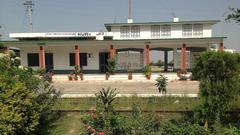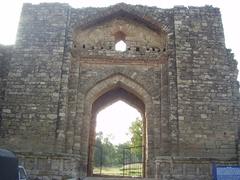
Visiting Pakistan Museum of Natural History: Tickets, Hours, and Tips
Date: 18/08/2024
Introduction
Welcome to the Pakistan Museum of Natural History, an essential destination for anyone intrigued by the wonders of biodiversity, geology, and history. Nestled in the scenic Shakarparian National Park in Islamabad, this museum is a treasure trove of knowledge, offering a captivating glimpse into Pakistan’s rich natural heritage. Whether you’re a history enthusiast, a student on an educational trip, or a family looking for an enlightening outing, this guide will provide you with all the information you need to make your visit unforgettable.
The museum boasts a diverse range of exhibits, each meticulously curated to offer a nearly lifelike experience. From the Bio Gallery showcasing Pakistan’s rich flora and fauna to the Tethys Gallery dedicated to the geological and oceanographic history of the region, there is something to pique everyone’s interest. Notable exhibits like the skeleton of a blue whale and a nearly 40-foot-long whale shark are must-sees that promise to leave visitors in awe (Scientia Mag; Guide to Pakistan).
In addition to its stunning exhibits, the museum offers a range of visitor amenities, including a cafeteria, gift shop, and wheelchair accessibility, ensuring a comfortable and enjoyable experience for all. Conveniently located near other attractions like the Lok Virsa Museum and the Pakistan Monument, the Pakistan Museum of Natural History is a cornerstone of Islamabad’s cultural and educational landscape (Zameen).
Table of Contents
Exhibits and Galleries
Bio Gallery
The Bio Gallery at the Pakistan Museum of Natural History is a treasure trove of biodiversity, showcasing the rich flora and fauna of Pakistan. This gallery features a vast collection of animal and bird specimens, meticulously preserved to offer a nearly lifelike experience. Visitors can explore the diverse habitats of Pakistan, from the alpine heights of the northern regions to the coastal ecosystems in the south. The gallery also includes detailed descriptions of the eco-regions and habitats of these species, providing a comprehensive understanding of Pakistan’s natural biodiversity (Scientia Mag).
Tethys Gallery
The Tethys Gallery is dedicated to the geological and oceanographic history of Pakistan. This gallery features a three-dimensional diorama of seascapes, showcasing the marine life and geological formations of the region. One of the highlights is the skeleton of a blue whale, which is prominently displayed. The gallery also delves into various aspects of petrology, pedology, and mineralogy, offering a detailed look at the earth sciences (Guide to Pakistan).
Palaeo Gallery
The Palaeo Gallery is a must-visit for history enthusiasts and children alike. This gallery houses fossils that date back as far as 650 million years, offering a glimpse into the prehistoric life that once roamed the region. Notable exhibits include the complete skeletons of an elephant and a giraffe. The gallery also features wall paintings and writings that discuss anthropology, including an Australopithecus skull, providing a comprehensive overview of the prehistoric period (Zameen).
Gemstones Gallery
For those fascinated by geology and mineralogy, the Gemstones Gallery is a highlight. This gallery displays a wide range of gemstones found naturally in Pakistan, including garnet, emerald, ruby, quartz, and aquamarine. The gems are showcased in both their natural and polished forms, offering a visual feast for visitors. This gallery not only highlights the natural beauty of these stones but also provides educational insights into their geological formation (Guide to Pakistan).
Ecological Gallery
The Ecological Gallery is an educational segment that explores ecological cycles, ecosystems, and environmental issues. This gallery uses a combination of visuals and audio to provide an immersive learning experience. It aims to educate visitors about the importance of ecological balance and the impact of human activities on the environment. This gallery is particularly relevant given the current global focus on environmental conservation (Guide to Pakistan).
Virtual Orientation Gallery
Established in 2016, the Virtual Orientation Gallery is the most recent addition to the museum. This interactive gallery is designed to engage younger visitors through virtual tours and educational games. The gallery offers its services in both English and Urdu, making it accessible to a wider audience. Visitors can take virtual tours of the other galleries, providing a comprehensive overview of the museum’s exhibits without having to physically move from one gallery to another (Zameen).
Notable Exhibits
Blue Whale Skeleton
One of the most iconic exhibits at the Pakistan Museum of Natural History is the skeleton of a blue whale, prominently displayed at the entrance. This massive skeleton serves as a striking introduction to the museum’s extensive collection of natural history exhibits. The blue whale is the largest animal known to have ever existed, and its skeleton provides a fascinating glimpse into the scale and complexity of marine life (Scientia Mag).
Whale Shark Display
Another significant exhibit is the Whale Shark display. The Whale Shark is the largest fish in the world, and the specimen on display at the museum is nearly 40 feet long. This particular whale shark was found dead on the coast near Karachi in 2012 and weighed nearly 16 tonnes. The specimen was mounted at the museum with the help of UNESCO, making it one of the largest and most impressive exhibits in the museum (Zameen).
Gharial Crocodile Display
The Gharial Crocodile display is another highlight. The gharial (Gavialis gangeticus) is a critically endangered species native to the northern part of the Indus River in Pakistan. The exhibit provides detailed information about the species, including its size, weight, and conservation status. This display aims to raise awareness about the plight of the gharial and the importance of conservation efforts (Scientia Mag).
Visitor Information
Timings and Tickets
The Pakistan Museum of Natural History is open every day from 9:30 am to 8:00 pm during the summer months (April to November) and from 9:30 am to 5:30 pm during the winter months (December to March). The museum is closed for prayers and lunch daily between 1:00 pm and 1:30 pm, with an extended break on Fridays from 12:45 pm to 2:15 pm. Tickets are priced at PKR 30 for local visitors, PKR 20 for students, and PKR 100 for foreigners. Children below the age of 5 can enter free of cost (Zameen).
Location
The museum is located within the Shakarparian National Park in the Shakarparian Hills. It can be easily reached via Garden Avenue after taking the Shakarparian Interchange on Islamabad Expressway/Faisal Avenue. The location is also convenient for visitors who wish to explore nearby attractions such as the Lok Virsa Museum and the Pakistan Monument (Zameen).
Booking and Accessibility
To avoid crowds, especially when visiting with family or student groups, it is advisable to book a specific time slot in advance. Visitors can call 0334-5524915 to book their visit. The museum is designed to be accessible to all visitors, including those with disabilities, ensuring a comfortable and educational experience for everyone (Zameen).
FAQs
What are the opening hours of the Pakistan Museum of Natural History?
The museum is open from 9:30 am to 8:00 pm during the summer months (April to November) and from 9:30 am to 5:30 pm during the winter months (December to March). It is closed daily between 1:00 pm and 1:30 pm, with an extended break on Fridays from 12:45 pm to 2:15 pm.
How much are tickets for the Pakistan Museum of Natural History?
Tickets are priced at PKR 30 for local visitors, PKR 20 for students, and PKR 100 for foreigners. Children below the age of 5 can enter free of cost.
What are some nearby attractions?
Nearby attractions include the Lok Virsa Museum and the Pakistan Monument, both of which are located within close proximity to the Pakistan Museum of Natural History.
Conclusion
By exploring these diverse galleries and exhibits, visitors to the Pakistan Museum of Natural History can gain a comprehensive understanding of the country’s rich natural heritage. Whether you’re interested in biodiversity, geology, or history, this museum offers an educational and engaging experience for all. Don’t forget to check out the notable exhibits like the blue whale skeleton and the whale shark display, and plan your visit to make the most out of this incredible destination.
With its convenient location in Shakarparian National Park and close proximity to other cultural landmarks like the Lok Virsa Museum and Pakistan Monument, the Pakistan Museum of Natural History is easily accessible and offers a full day of exploration and learning. The affordable ticket prices and various amenities such as a cafeteria, gift shop, and wheelchair accessibility ensure a comfortable and enriching experience for visitors of all ages and backgrounds. Don’t miss the opportunity to explore this incredible destination and gain a deeper appreciation for the natural world (Scientia Mag; Guide to Pakistan; Zameen).
References
- Scientia Mag, 2023, Unknown Author scientiamag.org
- Guide to Pakistan, 2023, Unknown Author guidetopakistan.pk
- Zameen, 2023, Unknown Author zameen.com


